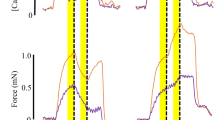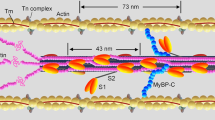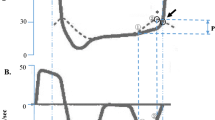Abstract
A PROCEDURE reducing the diffusion-limited equilibration time of the Ca2+ concentration within skinned muscle fibres1 activated from outside has been used to investigate the kinetics and the stoichiometry of Ca2+ in the process of tension development in frog skeletal muscle. The diffusion problems are minimised by activating (or relaxing) the myofibrillar preparation in a solution with a very high Ca2+-buffering capacity compared to that of the fibre as a whole2,3 (solution in the interfilament space, sarcoplasmic reticulum, myofibrillar proteins);by using only thin fibres; and by using an efficient pH buffer (TES: N-Tris (hydroxymethyl) methyl-2-aminoethanesulphonic acid) and a high ATP concentration in conjunction with a powerful ATP regenerative system (creatine phosphate (CP) and creatine kinase (CK)). Great care has been taken in preparing bathing solutions with similar concentrations of monovalent metallic cations (∼ 150 mM), protons (pH 7.1 )4 and [Mg2+](∼1 mM) (refs 5 and 6) to those in vivo. For this purpose, the apparent binding constants of the various ligands for Ca2+ and Mg2+ have been measured by a pH metric method (Table 1).
This is a preview of subscription content, access via your institution
Access options
Subscribe to this journal
Receive 51 print issues and online access
$199.00 per year
only $3.90 per issue
Buy this article
- Purchase on Springer Link
- Instant access to full article PDF
Prices may be subject to local taxes which are calculated during checkout
Similar content being viewed by others
References
Natori, R., Jikeikai med. J., 1, 119–126 (1954).
Ashley, C. C., and Moisescu, D. G., J. Physiol., Lond., 233, 8–9P (1973).
Moisescu, D. G., thesis, Univ. Bristol (1974).
Caldwell, P. C., J. Physiol., Lond., 142, 22–62 (1958).
Endo, M., Proc. Japan Acad., 51, 479–484 (1975).
Ashley, C. C., and Ellory, J. C., J. Physiol., Lond., 226, 653–674 (1972).
Sillén, L. G., and Martell, A. E., Stability Constants of Metal-ion Complexes (The Chemical Society, Special Publication No. 17, London, 1964).
Sillén, L. G., and Martell, A. E., Stability Constants of Metal-ion Complexes Supplement 1 (The Chemical Society, Special Publication No. 25, London, 1970).
Hill, A. V., Proc. R. Soc., B 136, 399–420 (1949).
Huxley, A. F., and Simmons, R. M., Nature, 233, 533–538 (1971).
Huxley, A. F., and Simmons, R. M., Cold Spring Harb. Symp. quant. Biol., 37, 660–680 (1972).
Endo, M., Tanaka, M., and Ogawa, Y., Nature, 288, 34–36 (1970).
Anderegg, G., Helv. Chim. Acta, 47, 1801–1814 (1964).
Ashley, C. C., Moisescu, D. G., and Rose, R. M., J. Physiol., Lond., 241, 104–106P (1974).
Julian, F. J., J. Physiol., Lond., 218, 117–146 (1971).
Hellam, D. C., and Podolsky, R. J., J. Physiol., Lond., 200, 807–819 (1969).
Endo, M., Nature new Biol., 237, 211–213 (1972).
Moisescu, D. G., Ashley, C. C., and Campbell, A. K., Biochim. biophys. Acta, 396, 133–140 (1975).
Ashley, C. C., and Moisescu, D. G., Nature new Biol., 237, 208–211 (1972).
Rodiguin, N. M., and Rodiguina, E. N., Consecutive Chemical Reactions, 42–46 (Van Nostrand, Princeton, 1964).
Lehman, W., and Szent-Györgyi, A. G., J. gen. Physiol., 66, 1–30 (1975).
Hazelgrove, J. C., Cold Spring Harb. Symp. quant. Biol., 37, 341–352 (1972).
Werber, M. M., Gaffin, S. L., and Oplatka, A., J. Mechanochem. Cell Motility, 1, 91–96 (1972).
Morimoto, K., and Harrington, W. F., J. molec. Biol., 83, 83–97 (1974).
Bremel, R. D., and Weber, A., Nature new Biol., 238, 97–101 (1972).
Potter, J. D., and Gergely, J., J. biol Chem., 250, 4628–4633 (1975).
Moisescu, D. G., and Pusch, H., Pflügers Arch., 355, R-122 (1975).
Taqui Khan, M. M., and Martell, A. E., J. Am. chem. Soc., 88, 668–671 (1966).
Phillips, R. C., George, P., and Rutman, R. J., J. Am. chem. Soc., 88, 2631–2640 (1966).
Porzehl, H., Caldwell, P. C., and Rüegg, J. C., Biochim. biophys. Acta, 79, 581–591 (1964).
Good, N. E., et al., Biochemistry, 5, 467–477 (1966).
Smith, R. M., and Alberty, R. A., J. Am. chem. Soc., 78, 2376–2380 (1956).
Author information
Authors and Affiliations
Rights and permissions
About this article
Cite this article
MOISESCU, D. Kinetics of reaction in calcium-activated skinned muscle fibres. Nature 262, 610–613 (1976). https://doi.org/10.1038/262610a0
Received:
Accepted:
Issue Date:
DOI: https://doi.org/10.1038/262610a0
This article is cited by
-
Altered fast- and slow-twitch muscle fibre characteristics in female mice with a (S248F) knock-in mutation of the brain neuronal nicotinic acetylcholine receptor
Journal of Muscle Research and Cell Motility (2009)
-
Cross-bridge movement in rat slow skeletal muscle as a function of calcium concentration
Pflügers Archiv - European Journal of Physiology (1996)
-
Inhibition of unloaded shortening velocity in permeabilized muscle fibres by caged ATP compounds
Journal of Muscle Research and Cell Motility (1995)
-
Analysis of Ca2+ and Sr2+ activation characteristics in skinned muscle fibre preparations with different proportions of myofibrillar isoforms
Journal of Muscle Research and Cell Motility (1995)
-
Calcium-activated and stretch-induced force responses in two biochemically defined muscle fibre types of the Norway lobster
Journal of Muscle Research and Cell Motility (1994)
Comments
By submitting a comment you agree to abide by our Terms and Community Guidelines. If you find something abusive or that does not comply with our terms or guidelines please flag it as inappropriate.



